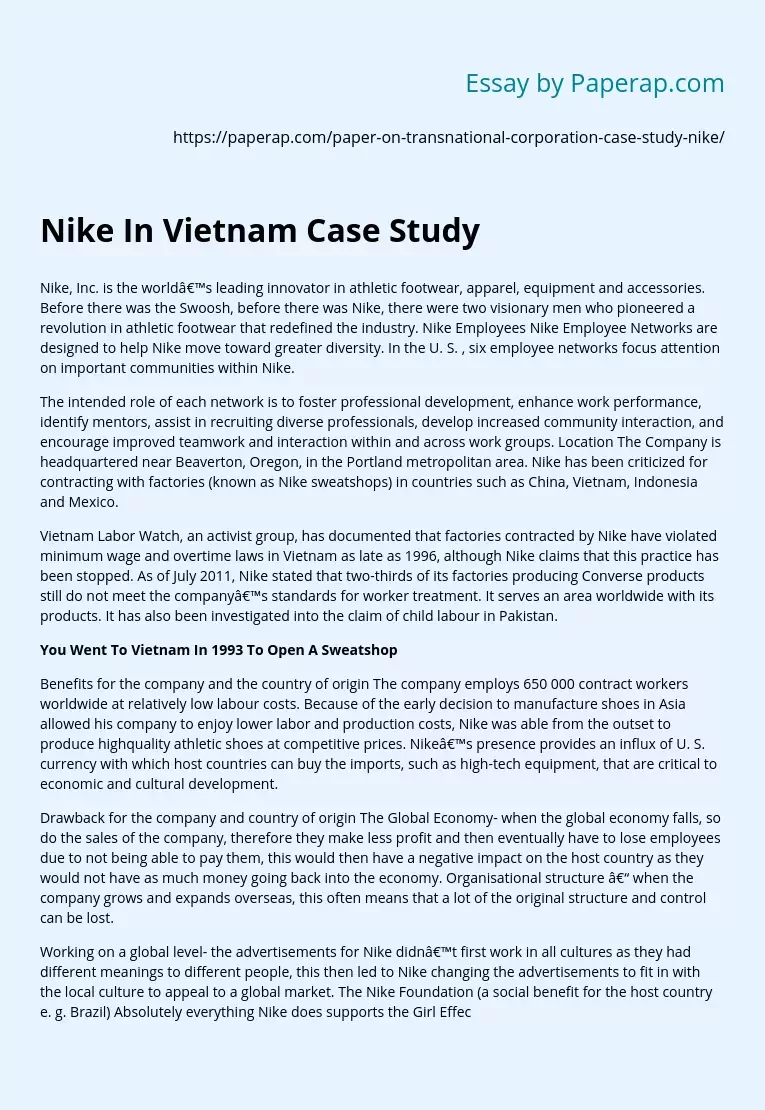Nike In Vietnam Case Study
Nike, Inc. is the world’s leading innovator in athletic footwear, apparel, equipment and accessories. Before there was the Swoosh, before there was Nike, there were two visionary men who pioneered a revolution in athletic footwear that redefined the industry. Nike Employees Nike Employee Networks are designed to help Nike move toward greater diversity. In the U. S. , six employee networks focus attention on important communities within Nike.
The intended role of each network is to foster professional development, enhance work performance, identify mentors, assist in recruiting diverse professionals, develop increased community interaction, and encourage improved teamwork and interaction within and across work groups.
Location The Company is headquartered near Beaverton, Oregon, in the Portland metropolitan area. Nike has been criticized for contracting with factories (known as Nike sweatshops) in countries such as China, Vietnam, Indonesia and Mexico.
Vietnam Labor Watch, an activist group, has documented that factories contracted by Nike have violated minimum wage and overtime laws in Vietnam as late as 1996, although Nike claims that this practice has been stopped.
As of July 2011, Nike stated that two-thirds of its factories producing Converse products still do not meet the company’s standards for worker treatment. It serves an area worldwide with its products. It has also been investigated into the claim of child labour in Pakistan.
You Went To Vietnam In 1993 To Open A Sweatshop
Benefits for the company and the country of origin The company employs 650 000 contract workers worldwide at relatively low labour costs. Because of the early decision to manufacture shoes in Asia allowed his company to enjoy lower labor and production costs, Nike was able from the outset to produce highquality athletic shoes at competitive prices.
Nike’s presence provides an influx of U. S. currency with which host countries can buy the imports, such as high-tech equipment, that are critical to economic and cultural development.
Drawback for the company and country of origin The Global Economy- when the global economy falls, so do the sales of the company, therefore they make less profit and then eventually have to lose employees due to not being able to pay them, this would then have a negative impact on the host country as they would not have as much money going back into the economy. Organisational structure – when the company grows and expands overseas, this often means that a lot of the original structure and control can be lost.
Working on a global level- the advertisements for Nike didn’t first work in all cultures as they had different meanings to different people, this then led to Nike changing the advertisements to fit in with the local culture to appeal to a global market. The Nike Foundation (a social benefit for the host country e. g. Brazil) Absolutely everything Nike does supports the Girl Effect: the unique potential of 250 million adolescent girls to end poverty for themselves and the world. Nike believes in the power of unleashing human potential – on the field, on the court, and in life.
At the Nike Foundation, they take the power of potential to a new playing field to combat one of the most pressing issues of their time: global poverty. When the Nike Foundation started in 2004, it sought the best investment with the highest returns. They traced the symptoms of poverty back to their roots, and it led them to an unexpected solution and a catalyst for change: adolescent girls. There are 250 million adolescent girls living in poverty in the developing world. That’s a quarter of a billion girls aged 10-19 living on less than $2 USD a day.
When a girl in the developing world realizes her potential, she isn’t the only one who escapes poverty – she brings her family, community, and country with her. It’s a leverage strategy that can’t be beat. That’s why adolescent girls are an exclusive focus. Investing in a girl stops poverty before it starts. Many girls migrate from the rural areas of Kenya to the city of Nairobi in search of opportunity. But quickly, these girls find that opportunities are limited. With no education and no prospects, often, she is left with her only asset: her body.
The Nike Foundation however, meant that girls could go into employment legally and safely. This then benefitted the host country as there was more legal employment and less spread of illness or disease. Benefits for the host country Increased education levels as girls are being educated to work rather than using her body to earn money, therefore better jobs can be found and therefore more money can be put back into the country. The increase in the level of jobs can provide better employment for people living in that country therefore increased money put back into the country.
Drawbacks for the host county As many young girls are moving to the city to find employment in these factories, the population left in the rural areas is ageing. This means that less work will be able to be done and is known as a ‘brain drain’ where all the talented young people move out of an area in search of job opportunities. The building of infrastructure to attract the TNC can end up costing the host country a lot of money, possibly more money than the GDP; therefore the country may end up in debt and then become unattractive for money lenders.
Nike In Vietnam Case Study. (2019, Dec 05). Retrieved from https://paperap.com/paper-on-transnational-corporation-case-study-nike/

